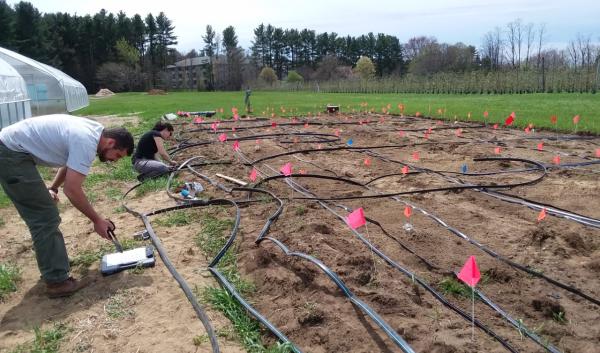After severe drought in much of the Northeast in 2016, the following summer reminded us that the trend in the Northeast is for more rainfall.
However, this rain is more often occurring in heavy downpours between periods of hot and dry weather. With this extreme and variable wet weather taking its toll on farms, a key question is: Does field crop irrigation make sense as a farm strategy given the number of wet summers in the Northeast? To find out, USDA Natural Resources Conservation Service, UVM Extension Center for Sustainable Agriculture and the Intervale Community Farm (ICF) in Burlington, Vermont joined forces.
“On a 100-year floodplain, ICF soils have long been recognized as productive farmland, albeit subject to flooding. The irony is that much of the floodplain that ICF farms is composed of sandy soils, which drain well but need to be irrigated during dry periods.” - Andy Jones, Farm Manager, Intervale Community Farm
The economic costs and benefits of irrigation at ICF were analyzed with data collected from 2006 to 2016.
To estimate irrigation needs in the years when data was not available, Cornell University’s Climate Smart Farming (CSF) Water Deficit Calculator was used to model when plant stress was likely to occur. In all but one year, the data showed that the benefits of avoided crop loss are greater than the costs of irrigation. According to the case study, if ICF can protect at least 3.5% of its crop revenues with irrigation as a risk management strategy, it will cover its costs of irrigation.
This study shows that irrigation is profitable despite on-going setup costs and variable summer weather.
Overall, the total net benefits per irrigated acre over 11 years was $33,121. The total farm benefits over all irrigated acres over 11 years were just over $500,000. Despite yearly rainfall, ICF would suffer reduced vegetable yields and quality without extra water. A range of irrigation scenarios were considered in order to identify thresholds of when irrigation is needed the most and the least. If all the years were “dry”, total farm benefits over 11 years due to irrigation would have exceeded $800,000. Even if all years were “wet”, total farm benefits would have remained positive at almost $70,000. The main reason for value in wet years is that these years may still have dry periods during critical crop growth stages when irrigation provides important benefits.
ICF’s decision to invest in drip and spray irrigation over the past 16 years has been sound.
The benefits of reducing losses due to summer water deficits has exceeded the costs of purchasing the equipment, running the pumps, and additional costs of labor and materials associated with managing the system. ICF was also able to keep their investment costs low by purchasing used equipment and by using existing wells. For other farms within the Northeast, the particular net benefits will depend upon their particular cost inputs and other local conditions. Each farm will have its own set of site-specific cost and benefit parameters.
Farming in a changing climate requires looking back to plan ahead.
In planning ahead for irrigation on farms, its important to revisit how the Northeast climate has already changed and how it’s projected to change. Between 1958 and 2010, the Northeast experienced more than a 70% increase in the amount of rain falling in very heavy events. Between 1895 and 2011, temperatures in the Northeast increased by almost 2 degrees F, and precipitation increased by approximately five inches. By 2080, warming impacts in the Northeast will be an additional 3 to 10 degrees F depending on the level of greenhouse gases emitted. The frequency, intensity and duration of heat waves are expected to increase. Precipitation is projected to increase particularly in the northern Northeast. Summers are becoming hotter and longer with seasonal drought risk projected to increase in the summer and fall as higher temperatures lead to greater evaporation and earlier snowmelt. For water management practices, there are lessons to be learned from these trends as well as significant events in the past decade. For example, during Hurricane Irene in late August 2011, very heavy rain was recorded at three inches per hour. In contrast, earlier that same summer, ICF experienced several dry hot weeks when their crops needed irrigation to alleviate plant stress.
Full case study Quick summary



